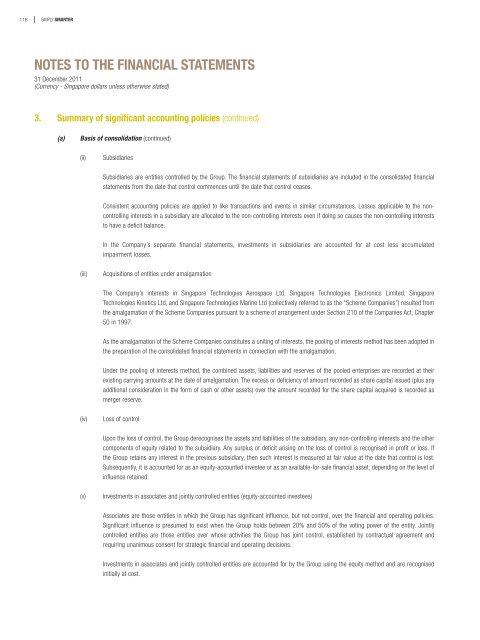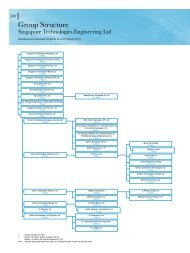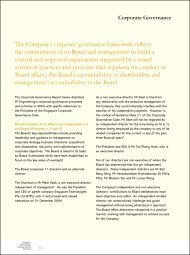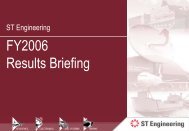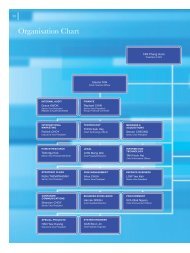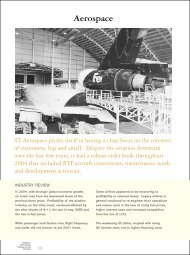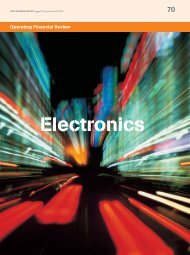notes to the financial statements - Singapore Technologies ...
notes to the financial statements - Singapore Technologies ...
notes to the financial statements - Singapore Technologies ...
You also want an ePaper? Increase the reach of your titles
YUMPU automatically turns print PDFs into web optimized ePapers that Google loves.
118 SIMPLY SMARTERNOTES TO THE FINANCIAL STATEMENTS31 December 2011(Currency - <strong>Singapore</strong> dollars unless o<strong>the</strong>rwise stated)3. Summary of significant accounting policies (continued)(a)Basis of consolidation (continued)(ii)SubsidiariesSubsidiaries are entities controlled by <strong>the</strong> Group. The <strong>financial</strong> <strong>statements</strong> of subsidiaries are included in <strong>the</strong> consolidated <strong>financial</strong><strong>statements</strong> from <strong>the</strong> date that control commences until <strong>the</strong> date that control ceases.Consistent accounting policies are applied <strong>to</strong> like transactions and events in similar circumstances. Losses applicable <strong>to</strong> <strong>the</strong> noncontrollinginterests in a subsidiary are allocated <strong>to</strong> <strong>the</strong> non-controlling interests even if doing so causes <strong>the</strong> non-controlling interests<strong>to</strong> have a deficit balance.In <strong>the</strong> Company’s separate <strong>financial</strong> <strong>statements</strong>, investments in subsidiaries are accounted for at cost less accumulatedimpairment losses.(iii)Acquisitions of entities under amalgamationThe Company’s interests in <strong>Singapore</strong> <strong>Technologies</strong> Aerospace Ltd, <strong>Singapore</strong> <strong>Technologies</strong> Electronics Limited, <strong>Singapore</strong><strong>Technologies</strong> Kinetics Ltd, and <strong>Singapore</strong> <strong>Technologies</strong> Marine Ltd (collectively referred <strong>to</strong> as <strong>the</strong> “Scheme Companies”) resulted from<strong>the</strong> amalgamation of <strong>the</strong> Scheme Companies pursuant <strong>to</strong> a scheme of arrangement under Section 210 of <strong>the</strong> Companies Act, Chapter50 in 1997.As <strong>the</strong> amalgamation of <strong>the</strong> Scheme Companies constitutes a uniting of interests, <strong>the</strong> pooling of interests method has been adopted in<strong>the</strong> preparation of <strong>the</strong> consolidated <strong>financial</strong> <strong>statements</strong> in connection with <strong>the</strong> amalgamation.Under <strong>the</strong> pooling of interests method, <strong>the</strong> combined assets, liabilities and reserves of <strong>the</strong> pooled enterprises are recorded at <strong>the</strong>irexisting carrying amounts at <strong>the</strong> date of amalgamation. The excess or deficiency of amount recorded as share capital issued (plus anyadditional consideration in <strong>the</strong> form of cash or o<strong>the</strong>r assets) over <strong>the</strong> amount recorded for <strong>the</strong> share capital acquired is recorded asmerger reserve.(iv)Loss of controlUpon <strong>the</strong> loss of control, <strong>the</strong> Group derecognises <strong>the</strong> assets and liabilities of <strong>the</strong> subsidiary, any non-controlling interests and <strong>the</strong> o<strong>the</strong>rcomponents of equity related <strong>to</strong> <strong>the</strong> subsidiary. Any surplus or deficit arising on <strong>the</strong> loss of control is recognised in profit or loss. If<strong>the</strong> Group retains any interest in <strong>the</strong> previous subsidiary, <strong>the</strong>n such interest is measured at fair value at <strong>the</strong> date that control is lost.Subsequently, it is accounted for as an equity-accounted investee or as an available-for-sale <strong>financial</strong> asset, depending on <strong>the</strong> level ofinfluence retained.(v)Investments in associates and jointly controlled entities (equity-accounted investees)Associates are those entities in which <strong>the</strong> Group has significant influence, but not control, over <strong>the</strong> <strong>financial</strong> and operating policies.Significant influence is presumed <strong>to</strong> exist when <strong>the</strong> Group holds between 20% and 50% of <strong>the</strong> voting power of <strong>the</strong> entity. Jointlycontrolled entities are those entities over whose activities <strong>the</strong> Group has joint control, established by contractual agreement andrequiring unanimous consent for strategic <strong>financial</strong> and operating decisions.Investments in associates and jointly controlled entities are accounted for by <strong>the</strong> Group using <strong>the</strong> equity method and are recognisedinitially at cost.


